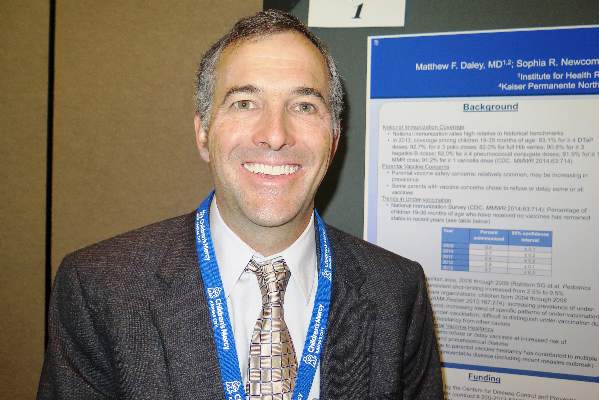User login
SAN DIEGO – Specific patterns of undervaccination in the first year of life, which may indicate parental vaccine refusal, are relatively uncommon, a large study showed.
“We should be encouraged, because it doesn’t seem like this is a problem greatly increasing in magnitude,” lead study author Dr. Matthew F. Daley said in an interview during a poster session at the annual meeting of the Pediatric Academic Societies. “But it still takes a lot of time and effort on the part of frontline clinicians to talk to these families and convince them to vaccinate. That goes on day in and day out, but at least the rates of parents who are deliberately refusing or spacing out vaccines seems stable over time.”
For the study, Dr. Daley, a pediatrician and senior investigator at Kaiser Permanente Colorado, Denver, and his associates evaluated the records of all children born from 2004 through 2013 who were part of six managed care organizations (MCOs) participating in the Vaccine Safety Datalink: Kaiser Permanente Colorado, Group Health Cooperative, Kaiser Permanente Northwest, Kaiser Permanente Southern California, Marshfield Clinic, and Kaiser Permanente Northern California. To be eligible, the children had to be enrolled continuously in their MCO from 6 weeks of age to their first birthday and have at least one well-child visit during the first year of life. The goal of the study ”was to identify nonstandard approaches to vaccination commonly endorsed by vaccine-hesitant parents,” the researchers wrote in their abstract. “There are many causes of undervaccination other than parental vaccine hesitancy; these were not the focus of the current study.”
The investigators focused on identifying five patterns: no vaccines (completely unvaccinated); first vaccine at 4-5 months of age; first vaccine at 6-11 months of age; pneumococcal conjugate (PCV7 or PCV13) and Haemophilus influenzae type b vaccines given on different days from diphtheria, tetanus, and acellular pertussis vaccine; and consistent limiting of vaccines (two or fewer vaccines per visit).
After data on patients with vaccine data errors and those without a well-child visit in the first year of life were excluded from the analysis, the final cohort included 444,679 patients. Dr. Daley and his associates found that from 2006 through 2008, all patients had a significant increasing trend for each pattern (P less than .01). From 2009 through 2013, there was no change for most trends (P greater than .05), except for the number of children with no vaccines (increasing, with a P value of less than .0001), and the number of children who received their first vaccine at 4-5 months of age (decreasing, P =.01).
Specific patterns of undervaccination occurred in about 515/10,000 children born in 2013, “which seems to indicate that parental hesitancy to vaccinate their children is still uncommon,” Dr. Daley said. “The one trend that’s increasing is the no vaccines received [pattern]. That seems like it’s still going up, but it’s still a slow change, and it’s still rare – about 1.5% of the total population. That’s a trend to keep an eye on, though, because those are kids who haven’t received any vaccines at all.”
Dr. Daley acknowledged certain limitations of the study, including the potential for misclassification, as children could have received their vaccines outside of the participating MCOs. He also said that the findings are likely to differ in an underinsured or uninsured population.
The study was funded by the Centers for Disease Control and Prevention. Dr. Daley reported having no relevant financial conflicts.
[email protected]
On Twitter @dougbrunk
SAN DIEGO – Specific patterns of undervaccination in the first year of life, which may indicate parental vaccine refusal, are relatively uncommon, a large study showed.
“We should be encouraged, because it doesn’t seem like this is a problem greatly increasing in magnitude,” lead study author Dr. Matthew F. Daley said in an interview during a poster session at the annual meeting of the Pediatric Academic Societies. “But it still takes a lot of time and effort on the part of frontline clinicians to talk to these families and convince them to vaccinate. That goes on day in and day out, but at least the rates of parents who are deliberately refusing or spacing out vaccines seems stable over time.”
For the study, Dr. Daley, a pediatrician and senior investigator at Kaiser Permanente Colorado, Denver, and his associates evaluated the records of all children born from 2004 through 2013 who were part of six managed care organizations (MCOs) participating in the Vaccine Safety Datalink: Kaiser Permanente Colorado, Group Health Cooperative, Kaiser Permanente Northwest, Kaiser Permanente Southern California, Marshfield Clinic, and Kaiser Permanente Northern California. To be eligible, the children had to be enrolled continuously in their MCO from 6 weeks of age to their first birthday and have at least one well-child visit during the first year of life. The goal of the study ”was to identify nonstandard approaches to vaccination commonly endorsed by vaccine-hesitant parents,” the researchers wrote in their abstract. “There are many causes of undervaccination other than parental vaccine hesitancy; these were not the focus of the current study.”
The investigators focused on identifying five patterns: no vaccines (completely unvaccinated); first vaccine at 4-5 months of age; first vaccine at 6-11 months of age; pneumococcal conjugate (PCV7 or PCV13) and Haemophilus influenzae type b vaccines given on different days from diphtheria, tetanus, and acellular pertussis vaccine; and consistent limiting of vaccines (two or fewer vaccines per visit).
After data on patients with vaccine data errors and those without a well-child visit in the first year of life were excluded from the analysis, the final cohort included 444,679 patients. Dr. Daley and his associates found that from 2006 through 2008, all patients had a significant increasing trend for each pattern (P less than .01). From 2009 through 2013, there was no change for most trends (P greater than .05), except for the number of children with no vaccines (increasing, with a P value of less than .0001), and the number of children who received their first vaccine at 4-5 months of age (decreasing, P =.01).
Specific patterns of undervaccination occurred in about 515/10,000 children born in 2013, “which seems to indicate that parental hesitancy to vaccinate their children is still uncommon,” Dr. Daley said. “The one trend that’s increasing is the no vaccines received [pattern]. That seems like it’s still going up, but it’s still a slow change, and it’s still rare – about 1.5% of the total population. That’s a trend to keep an eye on, though, because those are kids who haven’t received any vaccines at all.”
Dr. Daley acknowledged certain limitations of the study, including the potential for misclassification, as children could have received their vaccines outside of the participating MCOs. He also said that the findings are likely to differ in an underinsured or uninsured population.
The study was funded by the Centers for Disease Control and Prevention. Dr. Daley reported having no relevant financial conflicts.
[email protected]
On Twitter @dougbrunk
SAN DIEGO – Specific patterns of undervaccination in the first year of life, which may indicate parental vaccine refusal, are relatively uncommon, a large study showed.
“We should be encouraged, because it doesn’t seem like this is a problem greatly increasing in magnitude,” lead study author Dr. Matthew F. Daley said in an interview during a poster session at the annual meeting of the Pediatric Academic Societies. “But it still takes a lot of time and effort on the part of frontline clinicians to talk to these families and convince them to vaccinate. That goes on day in and day out, but at least the rates of parents who are deliberately refusing or spacing out vaccines seems stable over time.”
For the study, Dr. Daley, a pediatrician and senior investigator at Kaiser Permanente Colorado, Denver, and his associates evaluated the records of all children born from 2004 through 2013 who were part of six managed care organizations (MCOs) participating in the Vaccine Safety Datalink: Kaiser Permanente Colorado, Group Health Cooperative, Kaiser Permanente Northwest, Kaiser Permanente Southern California, Marshfield Clinic, and Kaiser Permanente Northern California. To be eligible, the children had to be enrolled continuously in their MCO from 6 weeks of age to their first birthday and have at least one well-child visit during the first year of life. The goal of the study ”was to identify nonstandard approaches to vaccination commonly endorsed by vaccine-hesitant parents,” the researchers wrote in their abstract. “There are many causes of undervaccination other than parental vaccine hesitancy; these were not the focus of the current study.”
The investigators focused on identifying five patterns: no vaccines (completely unvaccinated); first vaccine at 4-5 months of age; first vaccine at 6-11 months of age; pneumococcal conjugate (PCV7 or PCV13) and Haemophilus influenzae type b vaccines given on different days from diphtheria, tetanus, and acellular pertussis vaccine; and consistent limiting of vaccines (two or fewer vaccines per visit).
After data on patients with vaccine data errors and those without a well-child visit in the first year of life were excluded from the analysis, the final cohort included 444,679 patients. Dr. Daley and his associates found that from 2006 through 2008, all patients had a significant increasing trend for each pattern (P less than .01). From 2009 through 2013, there was no change for most trends (P greater than .05), except for the number of children with no vaccines (increasing, with a P value of less than .0001), and the number of children who received their first vaccine at 4-5 months of age (decreasing, P =.01).
Specific patterns of undervaccination occurred in about 515/10,000 children born in 2013, “which seems to indicate that parental hesitancy to vaccinate their children is still uncommon,” Dr. Daley said. “The one trend that’s increasing is the no vaccines received [pattern]. That seems like it’s still going up, but it’s still a slow change, and it’s still rare – about 1.5% of the total population. That’s a trend to keep an eye on, though, because those are kids who haven’t received any vaccines at all.”
Dr. Daley acknowledged certain limitations of the study, including the potential for misclassification, as children could have received their vaccines outside of the participating MCOs. He also said that the findings are likely to differ in an underinsured or uninsured population.
The study was funded by the Centers for Disease Control and Prevention. Dr. Daley reported having no relevant financial conflicts.
[email protected]
On Twitter @dougbrunk
AT THE PAS ANNUAL MEETING
Key clinical point: Undervaccination during the first year of life is uncommon.
Major finding: From 2009 through 2013, there was no change for most vaccination trends, except for the number of children with no vaccines (increasing, with a P value of less than .0001), and the number of children who received their first vaccine at 4-5 months of age (decreasing, P = .01).
Data source: An analysis of 444,679 children born from 2004 through 2013 who were part of six managed care organizations participating in the Vaccine Safety Datalink.
Disclosures: The study was funded by the Centers for Disease Control and Prevention. Dr. Daley reported having no relevant financial conflicts.


